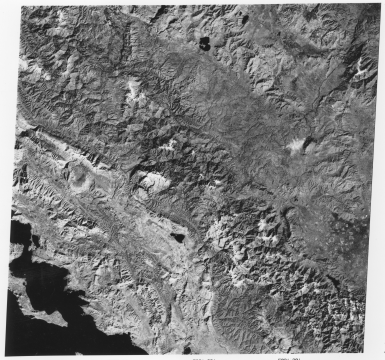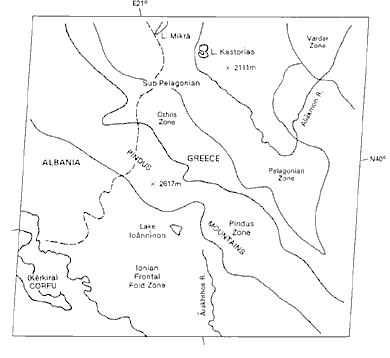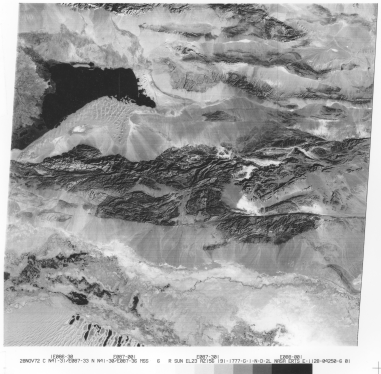

 running east-west through the Kuruk Tagh hills, composed of folded
sedimentary strata, metamorphic rocks and igneous intrusions.
The block of crust on the north side has shifted subhorizontally
to the west (left) at least 60 km relative to the block containing
the corresponding segment of mountains to the south. This is a
left-lateral wrench fault (also called a strike-slip fault), of
a type much like the San Andreas (a right-lateral fault, with
the Pacific plate moving northward against the North American
plate) - the famed earthquake-maker running from the Gulf of California
through the California Coast Ranges north of San Francisco [see
the Los Angeles image in Section 4 and the San Francisco image
in Section 6]). It is easily evident to the eye because of topographic
offset (as well as equivalent parts of the strata and metamorphosed
rock units), fault scarps, and displaced drainage. This and similar
major wrench faults in south-central Asia represent crustal adjustments
to the stresses induced by the collision of India against Asia
(see mosaic in Section 7).
running east-west through the Kuruk Tagh hills, composed of folded
sedimentary strata, metamorphic rocks and igneous intrusions.
The block of crust on the north side has shifted subhorizontally
to the west (left) at least 60 km relative to the block containing
the corresponding segment of mountains to the south. This is a
left-lateral wrench fault (also called a strike-slip fault), of
a type much like the San Andreas (a right-lateral fault, with
the Pacific plate moving northward against the North American
plate) - the famed earthquake-maker running from the Gulf of California
through the California Coast Ranges north of San Francisco [see
the Los Angeles image in Section 4 and the San Francisco image
in Section 6]). It is easily evident to the eye because of topographic
offset (as well as equivalent parts of the strata and metamorphosed
rock units), fault scarps, and displaced drainage. This and similar
major wrench faults in south-central Asia represent crustal adjustments
to the stresses induced by the collision of India against Asia
(see mosaic in Section 7).
Wrench faults have nearly vertical fault planes (surfaces of contact between blocks). A second type is the thrust fault, in which the fault plane is at low angles relative to Earth's surface and the usual direction of movement carries the upper (near-surface) block up and over the lower block. Thus, a mass of crust in a roughly tabular slice originating at some shallow depth is shoved (thrust) outwards over the fault plane, at least part of which may be actually placed over the surface ahead of it. Several such thrust slices (called sheets) may be stacked one on top of the other in a staggered pattern, leading to a sequence of thrust block bands that outcrop in succession in mountainous terrains. If each block consists of dominant rock types that are different from one another in composition and erosive response, these will appear at the surface as intervals of rock with contrasting topographic expressions. This is superbly displayed in the scene below of the Pindus Mountains of western Greece and Albania.


Five tectonic zones, named in this generalized map, can be differentiated by eye because of distinct topographic variations (and tonal differences related to contrasting rock types). The direction of tectonic transport is from east to west (right to left) causing the sheets to partially overlap below the surface but each front end to occupy a different geographic position relative to the one it overrode and the one overriding it. This zone of thrust belts is part of the Balkan Alpine system, an offshoot of the European Alps that runs subparallel to the Apennine Mountains of Italy (see Alps mosaic in section 7). As part of the tectonic adjustments required from the African Plate shoving northward against the European Plate, a small tectonic plate underlying the Tyrrhenian Sea (off Sardinia) is squeezed within the Adriatic plate pushing it eastward against the Aegian plate, underthrusting it and causing the thrust slicing shown here.
Code 935, Goddard Space Flight Center, NASA
Written by: Nicholas M. Short, Sr. email: nmshort@epix.net
and
Jon Robinson email: Jon.W.Robinson.1@gsfc.nasa.gov
Webmaster: Bill Dickinson Jr. email: rstwebmaster@gsti.com
Web Production: Christiane Robinson, Terri Ho and Nannette Fekete
Updated: 1999.03.15.